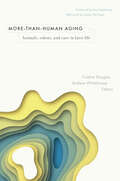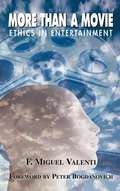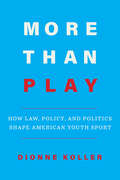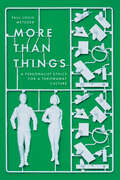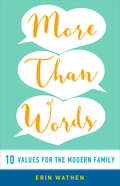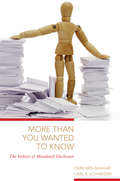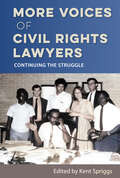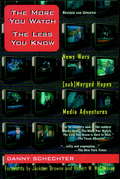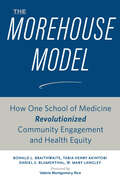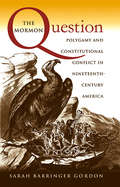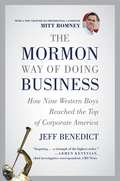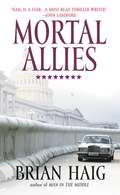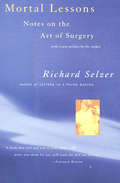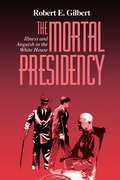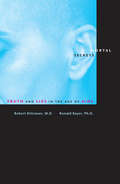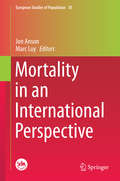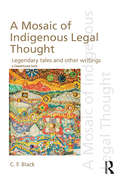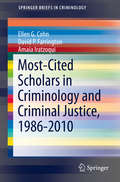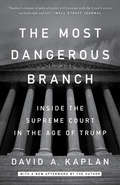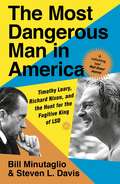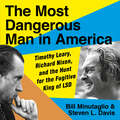- Table View
- List View
More-than-Human Aging: Animals, Robots, and Care in Later Life (Global Perspectives on Aging)
by Cristina Douglas Andrew WhitehouseWhat does later life look like when it is lived in the companionship of other species? Similarly, how do other species age (or not) with humans, and what sort of (a)symmetries, if any, are brought to light around how we understand and think about aging? So far, aging has been investigated in the social sciences in purely human terms. This is the first collection of original work that considers aging as taking place in relation to other species. This volume aims to start a conversation about aging by taking its more-than-human participants seriously—that is, not only as a support for or context of human aging but also, more symmetrically, as agents and subjects in the process of aging. The contributors draw upon richly descriptive ethnographic accounts, including moments of connection between seniors and dogs in a long-term care facility, human care for aging laboratory animals, and robotic companionship in later life. The ethnographies in this volume not only enrich our understanding of more-than-human companionship during the human aging process but also challenge and urge us to rethink what it means to live later in life in ecologically entangled social and moral worlds.
More Than Marriage: Forming Families after Marriage Equality
by John G. CulhaneIntroduces an expansive vision of the family and a brilliant legal arrangement that will protect the lives of millions of adults. Today, about half of all adults are unmarried. Many of those are in significant relationships—some intimate, others based in friendship, finances, or family ties—but the law offers them few protections. Amid the growing recognition that modern families take all shapes, More Than Marriage presents a refreshing vision for the future. With this book, noted family-law expert John G. Culhane takes us on a guided tour of how the march toward marriage equality spun off a number of other legal statuses, and explores how the law has expanded and where it falls short. This lively living history is grounded in relatable, in-depth interviews that give voice to the millions of Americans building family structures outside the protections of marriage—whether by choice, necessity, or exclusion. Culhane proposes an updated legal status that offers flexible and portable benefits for a diverse range of commitments and needs. As More Than Marriage shows, this "choose your own adventure" structure more accurately reflects, and more equitably protects, the many kinds of families we choose to build.
More Than A Movie: Ethics In Entertainment
by E. Miguel ValentiIn More Than a Movie, producer and entertainment attorney F. Miguel Valenti presents a compelling argument for the creative community to consider the consequences of its products, from movies to TV to the Internet. Valenti refrains from attacking the industries in which he himself works, but argues for reflection on the part of those who create media. More Than a Movie takes a pioneering first step toward outlining the issues in an insider fashion, and provides the tools to make ethical decisions about creating for the big and small screens. More Than a Movie is written to stimulate debate in professional and academic arenas, and for the enjoyment of everyone who loves entertainment.
More Than Play: How Law, Policy, and Politics Shape American Youth Sport
by Dionne KollerTens of millions of children in the United States participate in youth sport, a pastime widely believed to be part of a good childhood. Yet most children who enter youth sport are driven to quit by the time they enter adolescence, and many more are sidelined by its high financial burdens. Until now, there has been little legal scholarly attention paid to youth sport or its reform. Dionne Koller sets the stage for a different approach by illuminating the law and policy assumptions supporting a model that puts children's bodies to work in an activity that generates significant surplus value. In doing so, she identifies the wide array of beneficiaries who have a stake in a system that is much more than just play—and the political choices that protect these parties' interests at children's expense.
More Than Things: A Personalist Ethics for a Throwaway Culture
by Paul Louis MetzgerWe live in a culture of commodification. People are too often defined by what they do or own; they're treated as means to an end or cogs in a machine. What goes missing is a deep sense of personhood—the belief that all humans are unique subjects with inherent worth and the right to self-determination in authentic communion with others. In a world dominated by things, Paul Louis Metzger argues, we must work hard to account for one another's personhood. We need to cultivate relational structures that honor every human's dignity in vital interpersonal community. The theological and philosophical framework known as personalism can help guide us toward such a culture. Drawing from a wide range of thought leaders, including Martin Luther King Jr. and Pope John Paul II, Metzger presents a personalist moral vision founded on the Christian ideals of faith, hope, and love. He demonstrates how this moral compass can help us navigate a pluralistic world by applying it to a variety of pressing ethical issues, including abortion, genetic engineering, immigration, drone warfare, and more. Ultimately human personhood begins with the personal, triune God, who invites us to live more fully as human beings. When we refuse to reduce our fellow humans—and ourselves—to mere abstractions or objects, we follow the example of Jesus in honoring the value of every person and of creaturely life as a whole.
More than Words: 10 Values For The Modern Family
by Erin WathenThe values we live and raise our families by are grounded, first, in love. Contrary to many of today's so-called family values, our values go beyond one or two loaded social issues to a wholehearted lifestyle of practicing compassion, hospitality, justice, peace, and belonging. <P><P>More than Words articulates ten values that forward-thinking, openhearted people want to embody in their lives and pass on to their children. With practical ideas and thought-provoking questions, this book inspires families to live more intentionally, engage their communities, and make a difference in the world.
More Than You Wanted to Know: The Failure of Mandated Disclosure
by Omri Ben-Shahar Carl E. SchneiderHow mandated disclosure took over the regulatory landscape—and why it failedPerhaps no kind of regulation is more common or less useful than mandated disclosure—requiring one party to a transaction to give the other information. It is the iTunes terms you assent to, the doctor's consent form you sign, the pile of papers you get with your mortgage. Reading the terms, the form, and the papers is supposed to equip you to choose your purchase, your treatment, and your loan well. More Than You Wanted to Know surveys the evidence and finds that mandated disclosure rarely works. But how could it? Who reads these disclosures? Who understands them? Who uses them to make better choices?Omri Ben-Shahar and Carl Schneider put the regulatory problem in human terms. Most people find disclosures complex, obscure, and dull. Most people make choices by stripping information away, not layering it on. Most people find they can safely ignore most disclosures and that they lack the literacy to analyze them anyway. And so many disclosures are mandated that nobody could heed them all. Nor can all this be changed by simpler forms in plainer English, since complex things cannot be made simple by better writing. Furthermore, disclosure is a lawmakers' panacea, so they keep issuing new mandates and expanding old ones, often instead of taking on the hard work of writing regulations with bite.Timely and provocative, More Than You Wanted to Know takes on the form of regulation we encounter daily and asks why we must encounter it at all.
More Voices of Civil Rights Lawyers: Continuing the Struggle
by Kent SpriggsThe legal struggle for civil rights throughout the Southeast and into the 1980s In this book, twenty-three lawyers discuss their experiences in the struggle to advance and maintain civil rights in the United States South. While the lives of civil rights lawyers are often unknown or forgotten, this book draws attention to the importance of lawyers in facilitating dramatic sociopolitical changes, illustrates the realities of working in this profession, and shows the ways in which civil rights were—and still are—tested at every turn. The events documented here happened not just in the 1960s and ’70s but also in the 1980s, and this book highlights the emergence of a new generation of lawyers who continued to advocate for racial equity and expanded into other areas of social justice work, such as labor and gender. In addition, while the civil rights movement is commonly identified with protests in Deep South states, many of its activities and court challenges occurred beyond the region, and this book widens the geographic lens to include narratives from frontline lawyers in Texas, Florida, North Carolina, and Virginia. Many of the struggles documented in these firsthand accounts provide the context for contemporary civil rights concerns, including voting rights. As gains from this historic period are being contested and even rolled back, these narratives help readers remember the ubiquity of injustices in that time and to recognize the systemic discrimination and racism that continue to undermine basic civil rights today. Contributors: Robert L. Wiggins Jr. | James Blacksher | Alan Levine | Melvyn R. Leventhal | David Rudovsky | James Ayers | Chevene King Jr. | John Gresham | David Kern | Jack Drake | Stephen Oleskey | Kent Hull | Kent Spriggs | Charles Stephen Ralston | Barbara Phillips | Jim Rowan | Michael B. Trister | Bruce Rogow | Wilhelm H. Joseph | Kenneth Cloke | Gerry Hebert | Paul Harris | Martha Bergmark | Amy Ruth Tobol
The More You Watch the Less You Know
by Danny Schechter Robert Mcchesney Jackson BrowneA candid insider's tale of how the media really works and why it doesn't work the way it should, The More You Watch, The Less You Know has emerged as a key catalyst in the debate on media reform. The More You Watch, The Less You Know recounts Schechter's media adventures, from when he was "Danny Schechter the News Dissector" on Boston's WBCN radio, to his stints as a producer at ABC's 20/20 and CNN, to his personal odyssey chronicling the anti-Apartheid revolution in South Africa, to his development of innovative programming like South Africa Now and Rights & Wrongs as an independent producer. In this age of telecommunications bills and media mergers, The More You Watch, The Less You Know is an insider's passionate plea for freedom of the (electronic) press.
The Morehouse Model: How One School of Medicine Revolutionized Community Engagement and Health Equity
by Ronald L. Braithwaite Tabia Henry Akintobi Daniel S. Blumenthal W. Mary LangleyHow can the example of Morehouse School of Medicine help other health-oriented universities create ideal collaborations between faculty and community-based organizations?Among the 154 medical schools in the United States, Morehouse School of Medicine stands out for its formidable success in improving its surrounding communities. Over its history, Morehouse has become known as an institution committed to community engagement with an interest in closing the health equity gap between people of color and the white majority population. In The Morehouse Model, Ronald L. Braithwaite and his coauthors reveal the lessons learned over the decades since the school's founding—lessons that other medical schools and health systems will be eager to learn in the hope of replicating Morehouse's success. Describing the philosophical, cultural, and contextual grounding of the Morehouse Model, they give concrete examples of it in action before explaining how to foster the collaboration between community-based organizations and university faculty that is essential to making this model of care and research work. Arguing that establishing ongoing collaborative projects requires genuineness, transparency, and trust from everyone involved, the authors offer a theory of citizen participation as a critical element for facilitating behavioral change. Drawing on case studies, exploratory research, surveys, interventions, and secondary analysis, they extrapolate lessons to advance the field of community-based participatory research alongside community health.Written by well-respected leaders in the effort to reduce health inequities, The Morehouse Model is rooted in social action and social justice constructs. It will be a touchstone for anyone conducting community-based participatory research, as well as any institution that wants to have a positive effect on its local community.
The Mormon Question
by Sarah Barringer GordonFrom the Mormon Church's public announcement of its sanction of polygamy in 1852 until its formal decision to abandon the practice in 1890, people on both sides of the "Mormon question" debated central questions of constitutional law. Did principles of religious freedom and local self-government protect Mormons' claim to a distinct, religiously based legal order? Or was polygamy, as its opponents claimed, a new form of slavery--this time for white women in Utah? And did constitutional principles dictate that democracy and true liberty were founded on separation of church and state? As Sarah Barringer Gordon shows, the answers to these questions finally yielded an apparent victory for antipolygamists in the late nineteenth century, but only after decades of argument, litigation, and open conflict. Victory came at a price; as attention and national resources poured into Utah in the late 1870s and 1880s, antipolygamists turned more and more to coercion and punishment in the name of freedom. They also left a legacy in constitutional law and political theory that still governs our treatment of religious life: Americans are free to believe, but they may well not be free to act on their beliefs.
The Mormon Way of Doing Business: How Nine Western Boys Reached the Top of Corporate America
by Jeff BenedictThe Founder of JetBlue. The former CEO of Dell Computers. The CEO of Deloitte & Touche. The former Dean of the Harvard Business School. They all have one thing in common. They are devout Mormons who spend their Sundays exclusively with their families, never work long hours, and always put their spouses and children first. How do they do it? Critically acclaimed author and investigative journalist Jeff Benedict (a Mormon himself) examines these highly successful business execs and discovers how their beliefs have influenced them, and enabled them to achieve incredible success.With original interviews and unparalleled access, Benedict shares what truly drives these individuals, and the invaluable life lessons from which anyone can benefit.
Morson's English Guide for Court Reporters (2nd Edition)
by Lillian I. MorsonThis guide presents the fundamental rules for punctuating acceptable syntax and then goes a step further and presents verbatim English as found in courtroom transcripts and modifies the rules to accommodate this English. The grammar section and glossary offer a look at the way we name and define the elements in a sentence so that we can better understand standard word usage, spelling, and punctuation.
Mortal Lessons: Notes on the Art of Surgery
by Richard SelzerA surgeon shares true stories of life, death, and the human body in an essay collection that &“will nail you to your chair&” (Saturday Review). With settings ranging from the operating theater to a Korean ambulance, and topics as varied as the disposition of a corpse and the author&’s own childhood, these nineteen captivating, wry, and intimate vignettes offer a poignant examination of health, humanity, and, of course, mortality. Sometimes tragic, sometimes humorous, the essays offer a physician&’s viewpoint that goes beyond the medical to also consider the most meaningful issues and questions we face, whether as doctors or patients, cared for or caregiver. Praised by Kirkus Reviews as &“an impressive display of knowledge and art, magic and mystery,&” Mortal Lessons is a classic reflection on the human body and the human experience, and will resonate with readers for generations to come.
The Mortal Presidency: Illness and Anguish in the White House
by Robert E. GilbertAvailable in a new digital edition with reflowable text suitable for e-readersThe presidency is hazardous to your health. Fully two-thirds of our presidents have died before reaching their life-expectancy- despite being wealthier, better educated, and better cared for that most Americans. In Mortal Presidency, the first complete account of death and illness in the White House, Robert E. Gilbert looks at modern presidents including Coolidge, FDR, Eisenhower, Kennedy, and Reagan. He shows- in some cases, for the first time- that all suffered from debilitating medical problems, physical and/or psychological, which they frequently managed to conceal from the public but which, in important ways, affected their political lives. This edition is updated to include a brief look at Presidents Clinton and Bush, both of whom suffered sudden and unpleasant indispositions while in office which to some degree affected their presidencies.
Mortal Questions
by Thomas NagelThomas Nagel's Mortal Questions explores some fundamental issues concerning the meaning, nature and value of human life. Questions about our attitudes to death, sexual behaviour, social inequality, war and political power are shown to lead to more obviously philosophical problems about personal identity, consciousness, freedom, and value. This original and illuminating book aims at a form of understanding that is both theoretical and personal in its lively engagement with what are literally issues of life and death.
Mortal Secrets: Truth and Lies in the Age of AIDS
by Robert Klitzman Ronald BayerIn the era of the Internet and Oprah, in which formerly taboo information is readily available or freely confided, secrecy and privacy have in many ways given way to an onslaught of confession. Yet for those who are HIV positive, decisions about disclosure of their diagnosis force them to confront intimate, fundamental, and rarely discussed questions about truth, lies, sex, and trust.Drawing from interviews with over seventy gay men and women, intravenous drug users, sex workers, bisexual men, and heterosexual men and women, the authors provide a detailed portrait of moral, social, and psychological decision making. The interviews convey the complex emotions of love, lust, longing, hope, despair, and fear that shape individual dilemmas about whether to disclose to, deceive, or trust others concerning this disease. Some of those interviewed revealed their diagnosis widely; others told no one. Some struggled and ultimately told their partners; others spoke in codes or half-truths. One woman discovered her husband's diagnosis in a diary; when confronted, he denied it.Each year in the United States, 40,000 new cases of HIV arise, yet approximately one-third of the 900,000 Americans who are infected do not know it. As treatments have improved, unsafe sexual behavior has increased and efforts at prevention have stalled. Many of those infected continue to fear and experience rejection and discrimination. Addressing broad debates about the nature of secrecy, morality, and silence, this book explores public policy questions in the light of the nuanced, private decisions that are shaping the course of an epidemic and have broader indications for all.
Mortality in an International Perspective
by Jon Anson Marc LuyThis volume presents a state of the art coverage of the measurement and evolution of mortality over time. It describes in great detail the changes in the cause patterns of mortality, the changes in mortality patterns at different ages, and specific analyses of mortality in particular countries. Derived from a meeting of the European Working Group on Health, Morbidity and Mortality held at the Vienna Institute of Demography, September 2011, it presents a cross-section of the work and concerns of mortality researchers across Europe, ranging from London and Madrid in the west to Moscow in the east, with a few additions from further afield. Although most of the papers focus on a particular population, the range of the papers is broad; taken together they present an inter-disciplinary cross-section of this multi-faceted field. Coverage includes estimating life expectancy in small areas, with an application to recent changes in US counties; socioeconomic determinants of mortality in Europe using the latest available data and short-term forecasts; predicting mortality from profiles of biological risk and performance measures of functioning; infant mortality measurement and rate of progress on international commitment using evidence from Argentina; avoidable factors contributing to maternal deaths in Turkey; changes in mortality at older ages: the case of Spain (1975- 2006); variable scales of avoidable mortality within the Russian population; long-term mortality decline in East Asia, and much more. Perspectives in Mortality Research will serve as a valuable resource for professionals and students in sociology, demography, public health and personal finance.
Mortuary Law
by Thomas F. H. Stueve T. Scott GilliganThe rapid pace of change and developments in the laws that govern the funeral profession and the death care industry necessitate yet another update of Mortuary Law. Congress and federal regulators have instituted new privacy laws, modified the ADA, updated wage & hour regulations, and changed the tax code in several ways that impact funeral homes. State egislature have also played an important part by enacting or amending right of disposition statutes, increasing preneed and cremation regulations, and adopting regulatory schemes for new forms of disposition such as alkaline hydrolysis. <p><p>On the publication of this Eleventh Revision of this Mortuary Law, I would like to thank Karen Giles, the President of the Cincinnati College of Mortuary Science for the continuing opportunity to update Mortuary Law. I would also like to thank Patty Carter for her invaluable administrative assistance.
A Mosaic of Indigenous Legal Thought: Legendary Tales and Other Writings
by C.F. BlackThis book offers an Indigenous supplement to the rich and growing area of visual legal scholarship. Organized around three narratives, each with an associated politico-poetic reading, the book addresses three major global issues: climate change, the trade in human body parts and bio-policing. Manifesting and engaging the traditional storytelling mode of classical Indigenous ontology, these narratives convey legal and political knowledge, not merely through logical argument, but rather through the feelings of law and the understanding of lawful behaviour produced by their rhythm. Through its own performativity, therefore, the book demonstrates how classical Indigenous legal traditions remain vital to the now pressing challenge of making peace with the earth.
Most-Cited Scholars in Criminology and Criminal Justice, 1986-2010
by Ellen G. Cohn David P. Farrington Amaia Iratzoqui This brief examines the influence and prestige of scholars and works in the field of Criminology and Criminal Justice, as well as changes in influence and prestige over a period of 25 years, based on citation analysis. Methods of measuring scholarly influence can be highly controversial, but the authors of this work clearly outline their methodology, developed over years of experience working with this area of study. Through their expertise in Criminology and Criminal Justice, they are able to solve problems that affect or confound many traditional forms of citation analysis, such as irregularly cited references or self-citations. It includes 25 years of data (1986 through 2010) on the most-cited scholars and works in major American and international Criminology and Criminal Justice journals, and provides an objective measure of influence and prestige. Through an analysis of the data, the authors also document the intellectual development of criminology and criminal justice as a field of study since 1986. They highlight the development of research trends and indicate areas for future research. This book is designed for use by scholars and academics in the fields of Criminology and Criminal Justice, and the methodology will be of interest to researchers in related disciplines, including Sociology and Social Psychology. -- Cohn, Farrington, and Iratzoqui provide an invaluable service in unpacking the criminological enterprise. Using systematic citational analysis, they illuminate the core patterns of scholarly influence that have shaped the field's development. This volume is an essential resource for all those wishing to understand which scholars and writings have done most--within and across time periods--to affect thinking about crime and justice. Francis T. CullenDistinguished Research ProfessorUniversity of Cincinnati - Citation analyses have become one of the most significant measures of scholarly influence. They are especially useful for revealing major trends over time regarding authors and the topics of interest to the wider field. Cohn, Farrington, and Iratzoqui's Most Cited Scholars in Criminology and Criminal Justice, 1986-2010 provides the most up-to-date, comprehensive, and longitudinal investigation of scholarly influence in criminology/criminal justice. This resource is a most interesting read, one that supplies not a mere counting of citations but clear ideas about where the field has been centered and where it is trending into the future. Alex R. PiqueroAshbel Smith Professor of Criminology University of Texas at Dallas
The Most Dangerous Branch: Inside the Supreme Court's Assault on the Constitution
by David A. KaplanIn the bestselling tradition of The Nine and The Brethren, The Most Dangerous Branch takes us inside the secret world of the Supreme Court. David A. Kaplan, the former legal affairs editor of Newsweek, shows how the justices subvert the role of the other branches of government—and how we’ve come to accept it at our peril. With the retirement of Justice Anthony Kennedy, the Court has never before been more central in American life. It is the nine justices who too often now decide the controversial issues of our time—from abortion and same-sex marriage, to gun control, campaign finance and voting rights. The Court is so crucial that many voters in 2016 made their choice based on whom they thought their presidential candidate would name to the Court. Donald Trump picked Neil Gorsuch—the key decision of his new administration. The next justice—replacing Anthony Kennedy—will be even more important, holding the swing vote over so much social policy. Is that really how democracy is supposed to work? Based on exclusive interviews with the justices and dozens of their law clerks, Kaplan provides fresh details about life behind the scenes at the Court – Clarence Thomas’s simmering rage, Antonin Scalia’s death, Ruth Bader Ginsburg’s celebrity, Breyer Bingo, the petty feuding between Gorsuch and the chief justice, and what John Roberts thinks of his critics. Kaplan presents a sweeping narrative of the justices’ aggrandizement of power over the decades – from Roe v. Wade to Bush v. Gore to Citizens United, to rulings during the 2017-18 term. But the arrogance of the Court isn’t partisan: Conservative and liberal justices alike are guilty of overreach. Challenging conventional wisdom about the Court’s transcendent power, The Most Dangerous Branch is sure to rile both sides of the political aisle.
The Most Dangerous Man in America: Timothy Leary, Richard Nixon and the Hunt for the Fugitive King of LSD
by Steven L. Davis Bill Minutaglio'It's a rollicking tale that brings to life the antic atmosphere of America in the 'Me' Decade' Wall Street Journal'A madcap chase... this is a well-written chronicle of 28 months when the world went slightly mad' Sunday Times'A suitably head-spinning account of LSD High Priest Dr Timothy Leary' Mail on SundayOn the moonlit evening of September 12, 1970, an ex-Harvard professor with a genius IQ studies a twelve-foot high fence topped with barbed wire. A few months earlier, Dr. Timothy Leary, the High Priest of LSD, had been running a gleeful campaign for California governor against Ronald Reagan. Now, Leary is six months into a ten-year prison sentence for the crime of possessing two marijuana cigarettes.Aided by the radical Weather Underground, Leary's escape from prison is the counterculture's union of "dope and dynamite," aimed at sparking a revolution and overthrowing the government. Inside the Oval Office, President Richard Nixon drinks his way through sleepless nights as he expands the war in Vietnam and plots to unleash the United States government against his ever-expanding list of domestic enemies. Antiwar demonstrators are massing by the tens of thousands; homemade bombs are exploding everywhere; Black Panther leaders are threatening to burn down the White House; and all the while Nixon obsesses over tracking down Timothy Leary, whom he has branded "the most dangerous man in America."Based on freshly uncovered primary sources and new firsthand interviews, THE MOST DANGEROUS MAN IN AMERICA is an American thriller that takes readers along for the gonzo ride of a lifetime. Spanning twenty-eight months, President Nixon's careening, global manhunt for Dr. Timothy Leary winds its way among homegrown radicals, European aristocrats, a Black Panther outpost in Algeria, an international arms dealer, hash-smuggling hippies from the Brotherhood of Eternal Love, and secret agents on four continents, culminating in one of the trippiest journeys through the American counterculture.
The Most Dangerous Man in America: Timothy Leary, Richard Nixon and the Hunt for the Fugitive King of LSD
by Steven L. Davis Bill Minutaglio'It's a rollicking tale that brings to life the antic atmosphere of America in the 'Me' Decade' Wall Street Journal'A madcap chase... this is a well-written chronicle of 28 months when the world went slightly mad' Sunday TimesFrom Bill Minutaglio and Steven L. Davis, authors of the PEN Center USA award-winning Dallas 1963, comes a madcap narrative about Timothy Leary's daring prison escape and run from the law.On the moonlit evening of September 12, 1970, an ex-Harvard professor with a genius IQ studies a twelve-foot high fence topped with barbed wire. A few months earlier, Dr. Timothy Leary, the High Priest of LSD, had been running a gleeful campaign for California governor against Ronald Reagan. Now, Leary is six months into a ten-year prison sentence for the crime of possessing two marijuana cigarettes.Aided by the radical Weather Underground, Leary's escape from prison is the counterculture's union of "dope and dynamite," aimed at sparking a revolution and overthrowing the government. Inside the Oval Office, President Richard Nixon drinks his way through sleepless nights as he expands the war in Vietnam and plots to unleash the United States government against his ever-expanding list of domestic enemies. Antiwar demonstrators are massing by the tens of thousands; homemade bombs are exploding everywhere; Black Panther leaders are threatening to burn down the White House; and all the while Nixon obsesses over tracking down Timothy Leary, whom he has branded "the most dangerous man in America."Based on freshly uncovered primary sources and new firsthand interviews, THE MOST DANGEROUS MAN IN AMERICA is an American thriller that takes readers along for the gonzo ride of a lifetime. Spanning twenty-eight months, President Nixon's careening, global manhunt for Dr. Timothy Leary winds its way among homegrown radicals, European aristocrats, a Black Panther outpost in Algeria, an international arms dealer, hash-smuggling hippies from the Brotherhood of Eternal Love, and secret agents on four continents, culminating in one of the trippiest journeys through the American counterculture.(P)2018 Hachette Audio
